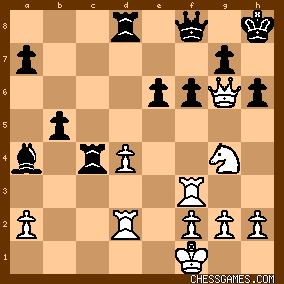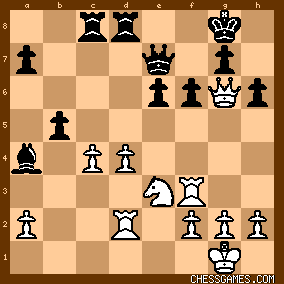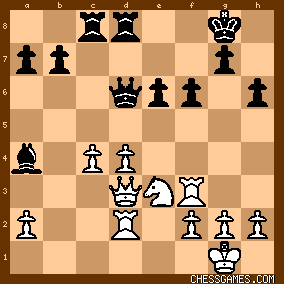|
< Earlier Kibitzing · PAGE 2 OF 3 ·
Later Kibitzing> |
| Aug-05-04 | | acirce: Kasparov gives "!" marks to 19..Nd5!, 25..h6!, 26..Qf4!, 27..Ba4! and 30..f5! And also 16.Bh4! for White, someone should point it out if I'm missing/forgetting any move here. |
|
| Aug-05-04 | | acirce: <16.Bh4! for White> hmm.. that is 17.Bh4 in this version of the game. He is mentioning that the move order depends on the source. |
|
| May-19-06 | | nezhmet: A very modern game by Steinitz. He understood that exchanging a pair of knights is important in this structure and he also understood that the black queen's arrival on f4 is key for both attack and defense (it arrived twice!). An excellent game playing against hanging pawns. The tactical miscues on both sides pointed out by annotators do not detract from the overall scheme of the game. |
|
Jun-01-06
 | | Honza Cervenka: <Much stronger was the tactical blow 29...b5! suggested by Vukovic.> I cannot help to myself but after many and many hours of analysing this I was unable to find any satisfactory (even equalising, not to mention winning) continuation for black after 29...b5 30.Qg6 Qe7 31.Ng4! If there is really nothing good for black in this line and if 29...Bc6 can be successfully met with 30.d5 exd5 31.Nf5 Qf8 32.Rg3 (suggested by GK in OMGP), then the evaluation of the position should be quite different. |
|
| Jun-16-06 | | GeauxCool: It's the positional play that won Steinitz so many victories. Zukertort's combinative play was equal to Steinitz', but he took too many chances with his pawn structure. In this game, Steinitz outmaneuvers Zukertort by simple positional principles. - Fine |
|
Sep-12-06
 | | Honza Cervenka: <Steinitz outmaneuvers Zukertort by simple positional principles. - Fine> I am afraid that Fine's comment (as well as other similar comments of many other great players who annotated this game) is too much influenced by result. In fact, the position after white's move 29 is pretty complex and highly unclear. Vukovic's idea 29...b5 with continuation 30.Qg6 Qe7 mentioned by GK in OMGP gives white more than sufficient counter-play after 31.Ng4! Rxc4 32.h3 (see diagram) with very dangerous attack. In fact, I would say that white is already clearly better here.
click for larger viewThe question is whether black has anything better than that. The improvement of Vukovic's and Kasparov's line can be 29...b5 30.Qg6 Qf8!? as from here the Queen covers Ph6. The idea is that now after 31.Ng4 black can play (immediately or after Rxc4) Kh8. For example, 29...b5 30.Qg6 Qf8 31.Ng4 Rxc4 32.Kf1! (32.g3 or 32.h3 would limit Rook's mobility) 32...Kh8 (see diagram) 
click for larger view33.Rh3 Rc1+ 34.Ke2 b4 35.Nxf6! Bb5+ 36.Rdd3 Bxd3+ 37.Kxd3 Rxd4+! 38.Ke2! (38.Kxd4 Qxf6+ is less accurate.) with mutually forced repetition of moves after 38...Rc2+ 39.Ke3 (39.Qxc2? Qxf6  ) 39...Rc3+ (Of course, not 39...Qxf6 for 40.Rxh6+ Kg8 41.Qh7+, 42.Rxf6+ and 43.Qxc2 ) 39...Rc3+ (Of course, not 39...Qxf6 for 40.Rxh6+ Kg8 41.Qh7+, 42.Rxf6+ and 43.Qxc2  ) 40.Ke2 (40.Kxd4? Qd6+ 41.Ke4 Rc4+ ) 40.Ke2 (40.Kxd4? Qd6+ 41.Ke4 Rc4+  with winning attack of black) 40...Rc2+ etc. with winning attack of black) 40...Rc2+ etc. |
|
Sep-12-06
 | | keypusher: <honza> thanks for your analysis of this interesting game -- I look forward to spending some time with it. <nezhmet> For the benefit of us non-masters, could you explain why it is important to trade off a pair of knights? <Calli> I realize your comments are two years old, but FWIW I think volumes IV and V of OMGP are much better than Vol. I. Even so, although I don't regret getting the series, there are probably more efficient ways to spend your chess dollars. |
|
Dec-16-06
 | | Chessical: <Honza Cervenka> In Vukovic's line <29...b5> 30.Qg6 Qe7 with your move <31.Ng4>, Black could perhaps try: <31...f5!?> e.g. 32.Nxh6+ Kf8 33.Qh7 gxh6 34.Qxh6+ Kf7 (not 34...Ke8? 35.Rg3!) with Qf6 to follow. This is a very sharp position and maybe Zukertort with his combinative skill could have survived it? |
|
Feb-01-07
 | | Honza Cervenka: <Chessical> I think that the question here is not whether Zukertort (i.e. white) could have survived but whether black would have been able to save the game against the best play of white after 29...b5 30.Qg6 Qe7 (Vukovic's/Kasparov's suggestion) 31.Ng4! (possibly a refutation). It seems to be that also after 31...f5 32.Nxh6+ Kf8 white's attack is very powerful. For example, 33.Rg3 can be quite good for white here too. But without comp checking it is only a guess from my part at this moment. Maybe <Random Visitor>'s Rybka or Fritz 10 can help us here. |
|
| Feb-01-07 | | RandomVisitor: <Honza>The position is complicated - I will let Rybka run a while on this. |
|
| Feb-01-07 | | RandomVisitor: After 29...b5 30.Qg6 Qe7:

click for larger view(20-ply)
1. (0.66): 31.Ng4 Rxc4 32.h3 Rc1+ 33.Kh2 Qc7+ 34.Rg3 Bc2 35.Nxf6+ Kf8 36.Ne4 Bxe4 37.Qxe4 Rc3 2. (-0.54): 31.Rg3 Kh8 32.Rh3 f5 33.c5 Rxc5 34.Nf1 Rc6 35.d5 Rcd6 36.Re3 Qe8 3. (-0.68): 31.c5 Rxc5 32.dxc5 Rxd2 33.h3 Kh8 34.a3 Rd8 35.c6 b4 36.Ng4 Rf8 |
|
| Feb-01-07 | | RandomVisitor: After 29.Rd2:
(18-ply)
1. (*): 29...b5 30.Qg6 *This line falls apart for Black on deeper analysis, it seems2. (-0.38): 29...Rc7 30.Qg6 f5 31.h4 Be8 32.Qg3 b5 33.Qxd6 Rxd6 34.cxb5 Bxb5 35.d5 Ba6 36.Rf4 3. (-0.36): 29...Kh8 30.Qb1 a6 31.d5 b5 32.cxb5 Bxb5 33.h3 Bc4 34.Rg3 Rc7 35.Nxc4 Rxc4 36.Rgd3 4. (-0.31): 29...f5 30.g3 b5 31.d5 Qb4 32.a3 Qa5 33.Kg2 bxc4 34.Nxc4 Qa6 35.Ne3 Qxd3 36.Rxd3 5. (-0.31): 29...Be8 30.Qb3 b5 31.cxb5 Rc1+ 32.Nd1 Rdc8 33.Re3 R8c4 34.Re1 Bd7 35.Qb2 Qb4 36.Qxb4 |
|
| Feb-01-07 | | RandomVisitor: On 29...b5 30.Qg6:
30...Qf8 31.Ng4 Rxc4 32.Kf1!
30...Kh8 31.Rxf6 gxf6 32.Qxf6+ Kg8 33.Qg6+ Kf8 34.Qh6+ Ke8 35.c5 Qf8 36.Qxe6+ Qe7 37.Qg6+ Kd7 38.Re2 in both cases Black has trouble finding a continuation that is not drawn. |
|
Feb-02-07
 | | Honza Cervenka: <RandomVisitor> Thanks. It seems to be that Rybka has made the same conclusion as I did in my own analysis some time ago. Vukovic's 29...b5 was objectively the best move of black but after 30.Qg6 it would have led to the draw only with the best play from both sides. And the best play here is not 30...Qe7(?) which can be followed by powerful 31.Ng4! instead of much weaker 31.Rh3? Qf7  mentioned by Gazza in OMGP, but 30...Qf8!? (After 30...Kh8 white can force draw immediately by 31.Rxf6) 31.Ng4! Rxc4 32.Kf1! Kh8! 33.Rh3 etc. mentioned above. I think that these findings can shed a bit different light upon this game and especially Zukertort's play. It shows also clearly how fantastically complex the game of chess is.:-) mentioned by Gazza in OMGP, but 30...Qf8!? (After 30...Kh8 white can force draw immediately by 31.Rxf6) 31.Ng4! Rxc4 32.Kf1! Kh8! 33.Rh3 etc. mentioned above. I think that these findings can shed a bit different light upon this game and especially Zukertort's play. It shows also clearly how fantastically complex the game of chess is.:-) |
|
| Oct-03-07 | | outplayer: Trading the minor pieces is not good for white's standard plan in the positions with an isolated d-pawn. That's why Karpov criticizes 20.Be7 and I think that Kasparov doesn't like 21.Bd5 for the same reason. After 30.d5 Qe5! 31.Rg3 ed5 32.Qg6 Rc7 Karpov |
|
| Oct-23-07 | | notyetagm: From the wikipedia article on Steinitz:
<Johannes Zukertort vs Wilhelm Steinitz, Ch World (9th game of the match) 1886, Queen's Gambit Declined: Vienna. Quiet Variation (D37), 0-1 <Zukertort vs Steinitz, 1886; A good demonstration of Steinitz' positional principles. Black exchanges his powerful centre for two weak "hanging Pawns" on White's side and creates a powerful pressure against them.> |
|
| Feb-26-08 | | Knight13: <Black exchanges his powerful centre for two weak "hanging Pawns" on White's side and creates a powerful pressure against them.> Same principle taught in "Complete Book of Chess Strategy" by Jeremy Silman. |
|
| Aug-13-08 | | jira: After 29...b5 31. Qg6 Kh8 and according to my Crafty black keeps an advantage. I analyzed it with Crafty and it doesn't see a draw there after 31.Rxf6. |
|
Jul-08-09
 | | Honza Cervenka: <jira: After 29...b5 31. Qg6 Kh8 and according to my Crafty black keeps an advantage. I analyzed it with Crafty and it doesn't see a draw there after 31.Rxf6.> Try to find an improvement for black somewhere in this line: 29...b5 30.Qg6 Kh8 31.Rxf6 gxf6 32.Qxf6+ Kg8 33.Qg6+ Kf8 34.Qh6+ Ke8 35.c5 Qe7 36.Re2 Rc6 37.Ng4 (diagram) 
click for larger viewAfter 37...Rxc5 38.h3 I see no way for black to make any progress and in fact he can be already in troubles here again as after 38...Rc6 white can play 39.Ne5 Rdd6 (forced) 40.Nxc6 Rxc6 41.d5 Rd6 42.dxe6 (diagram) with advantage of white whose connected passers should win the game. 
click for larger view |
|
| Jan-24-10 | | kibitzwc: (698) Zukertort,Johannes Hermann - Steinitz,William [D11]
World Championship 1st USA (1), 11.01.1886
[Fritz 12 (30s)]
D11: Slav Defence: 3 Nf3 sidelines and 3...Nf6 4 e3 Bg4 1.d4 d5 2.c4 c6 3.e3 Bf5 4.Nc3 e6 5.Nf3 Nd7 6.a3 Bd6 7.c5 Bc7 8.b4 e5 9.Be2 Ngf6 10.Bb2 e4 11.Nd2 h5 12.h3 Nf8 13.a4 White plans b5 13...Ng6 14.b5 Nh4 15.g3 last book move 15...Ng2+ [15...Ng6 16.a5 Bxa5 17.bxc6 bxc6 18.Qa4 Bxc3 19.Bxc3µ] 16.Kf1= Nxe3+ 17.fxe3 Bxg3 18.Kg2 Bc7 [¹18...Qc7=] 19.Qg1?? [¹19.Qf1 Be6 20.Kf2=] 19...Rh6–+ 20.Kf1 Rg6 21.Qf2 Qd7 22.bxc6 [22.Rg1 Bxh3+ 23.Ke1 Ng4 24.Bxg4 Bxg4–+ (‹24...Rxg4 25.Rxg4 Qxg4 26.Nf1µ) ] 22...bxc6 23.Rg1 Bxh3+ 24.Ke1 Ng4 25.Bxg4 Bxg4 26.Ne2 Qe7 27.Nf4 [27.Kd1 Qg5 28.Kc2 Rf6–+] 27...Rh6 [27...Rf6 28.Qh4–+] 28.Bc3 [28.Rf1–+] 28...g5 29.Ne2 Rf6 30.Qg2 Rf3 31.Nf1 Rb8 [31...Bh3 32.Qxg5 Rxf1+ 33.Kd2 Rxa1 34.Bxa1–+] 32.Kd2?! [32.Rh1–+] 32...f5 [¹32...Bh3 33.Qxg5 Qxg5 34.Rxg5 Bxf1 35.Rg1–+] 33.a5?? [¹33.Nh2µ] 33...f4–+ 34.Rh1 [34.Kc1 fxe3 35.Be1 Qf7–+] 34...Qf7 35.Re1 [35.Kc2 fxe3 36.Be1–+] 35...fxe3+ 36.Nxe3 Rf2 37.Qxf2 [37.Rhf1 Rxg2 38.Rxf7 Rxe2+ 39.Rxe2 Kxf7 40.Nxg4 hxg4 41.Rg2–+] 37...Qxf2 38.Nxg4 Bf4+ 39.Kc2 hxg4 40.Bd2 e3 [¹40...Qf3 41.Nc1 Bxd2 42.Rh8+ Kd7 43.Rxb8 Bxe1 44.Rb3–+] 41.Bc1 Qg2 [¹41...Bc7 42.Bb2 Qf5+ 43.Kc1–+] 42.Kc3 [42.Rh8+ Kf7 43.Rxb8 Qe4+ 44.Kc3 Bxb8–+] 42...Kd7 [¹42...Bc7 43.Rh8+ Kf7 44.Rxb8 Bxa5+ 45.Rb4–+] 43.Rh7+ Ke6 44.Rh6+ Kf5 45.Bxe3 Bxe3 46.Rf1+ [46.Rh8 Rxh8 47.a6 Bf2 48.Rb1 Qf3+ 49.Kd2 Qe3+ 50.Kc2 Qxe2+ 51.Kb3 Rb8+ 52.Kc3 Bxd4+ 53.Kxd4 Qd2#] 46...Bf4 [46...Bf4 47.Rh7 Qxe2 48.Rxf4+ gxf4 49.Rh5+ Kg6 50.Rh6+ Kxh6 51.a6 Qf2 52.Kd3 Rb3#] 0–1 |
|
Apr-07-10
 | | jessicafischerqueen: This is the last of the four games played in St. Louis. |
|
| Apr-07-10 | | lost in space: <<jessicafischerqueen>: This is the last of the four games played in St. Louis.> Were is the beef? |
|
| Oct-26-10 | | jira: Hello,
after a longer time I analyzed this line again with computer (Houdini engine) and it gives this variation which end with perpetual check: b5 30. Qg6 Qf8 31. Ng4 Rxc4 32. Kf1 Kh8 33.
Rh3

click for larger viewRc1+ 34. Ke2 b4 35. Nxf6 Bb5+ 36. Rdd3 Bxd3+ 37. Kxd3 Rxd4+ 38. Ke2 Qxf6
39. Rxh6+ Kg8 40. Qe8+ Qf8 41. Qxe6+ Qf7 42. Rh8+ Kxh8 43. Qxf7 Rc2+ 44. Kf3
Rc3+ 45. Ke2 Rc2+ *

click for larger view |
|
| Oct-26-10 | | jira: 
click for larger viewInstead of 29. .. b5 computer recommends
29. . Kh8 and gives this line
29. .. Kh8 30. Qb1 b5 31. cxb5 Qc7 *

click for larger viewWith a better game for black |
|
Jun-10-11
 | | Honza Cervenka: After some time I have returned to this fascinating game and position after 29.Rd2. My current opinion is that neither text 29...Bc6 nor Vukovic's 29...b5, which was backed by Gazza in OMGP too, are giving black any advantage against white's best play and even could get black in troubles as it was pointed out in previous comments. If black can keep some edge here he must apparently take care about safety of his Kingside at first. Prophylactic 29...Kh8 or maybe 29...f5 are worth of consideration. After 29...f5 I have analyzed 30.g4!? Bc6 31.d5 f4 32.Nf5!? exf5 33.dxc6 Rxc6 34.Qxd6 Rcxd6 35.Rxd6 Rxd6 36.Rxf4 fxg4 with better Rook ending for black but I am not sure whether it is winnable or not. |
|
 |
 |
|
< Earlier Kibitzing · PAGE 2 OF 3 ·
Later Kibitzing> |





